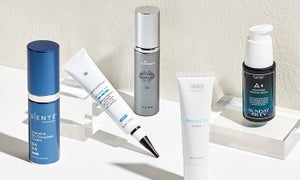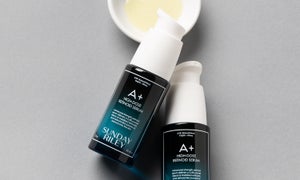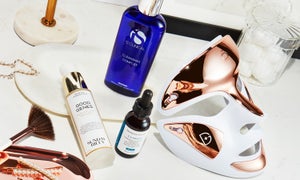
Chances are, you’ve heard about the wrinkle-reducing benefits of retinol, but might not understand exactly what this hero ingredient is—or everything it can do for your skin. In essence, retinol belongs to the class of ingredients known as retinoids, which are derived from vitamin A. Retinol works to stimulate collagen production and accelerate skin turnover, smoothing fine lines and wrinkles and fading acne marks, discoloration and blemishes in the process. You’ll find retinol as a star ingredient in many anti-aging serums and creams.
Given retinol’s impressive benefits, it's a favorite among many dermatologists. To help you understand retinol and how best to use it, we asked top dermatologists to dig deeper into how to make retinol work for your skin.
How to Apply Retinol for Best Results
As effective as retinol is when it comes to reversing damage, how you apply it can affect the results you see. Because this product can cause skin to dry out and sometimes turn red, it’s best to talk to your dermatologist before starting a retinol regimen. Most dermatologists advise to start with products that contain a low concentration (0.25% or 0.3%) of the ingredient first and see how your skin reacts before moving to higher concentrations.
Here's how to incorporate retinol into your skin care routine:
Step 1: Wash your face and apply eye cream. An eye cream will help protect the delicate skin around your eyes.
Step 2: Wait a few minutes until your skin is completely dry. This is important, because if your skin is at all damp, the retinol will be able to absorb more deeply into your skin and might cause irritation. We want to apply moisturizers and serums to slightly damp skin, but never retinol.
Step 3: Take a pea-size amount of your retinol and, starting at your chin, apply with your fingertips in upward and outward motions.
Step 4: Finish with your moisturizer.
Step 5: Remember to apply a broad-spectrum sunscreen the morning after, as retinol makes skin more sensitive to the sun.
How Often to Apply Retinol
Start by applying a pea-size amount of retinol to your entire face every other night, recommends Dr. Joshua Zeichner, a board-certified dermatologist and director of cosmetic and clinical research at Mount Sinai Hospital in New York. Remember that it takes several weeks for your skin to adjust to the product, so it’s best to use it sparingly at first and gradually increase your use as time goes on. If your skin becomes dry or irritated, Dr. Zeichner suggests holding back to every third night or even once per week.
The Best Skin Care Products to Use With Retinol
When first starting a retinol regimen, or if your skin is sensitive, it’s best not to combine retinol with other potentially irritating ingredients, such as alpha or beta hydroxy acids or physical exfoliants and scrubs. The best product you can use in conjunction with retinol, according to Dr. Zeichner, is a moisturizer, which can help hydrate skin and reduce the risk of irritation from retinol. “Some people even prefer to mix their retinol with a moisturizing cream to dilute it out,” he says.
If you want to use other active ingredients (such as vitamin C) as part of your skin care routine, consider using them at a different time of the day than when you apply your retinol product. Dr. Jason Emer, a board-certified dermatologist in Beverly Hills, California, says, "I prefer to use my vitamin C during the day to fight free radical damage and my retinol, peptides and growth factors at night."
One product you must use every morning, according to Dr. Zeichner? “[Retinol] can make you more sensitive to the sun so make sure to wear a daily sunscreen.”
When to Expect Results
As with any other skin care product, the key to seeing results is consistent use. “Retinol will not deliver visible results quickly, so patience is essential,” says Dr. Shereene Idriss, a board-certified dermatologist at Union Square Laser Dermatology and clinical instructor at Mount Sinai Hospital in New York. “Improvements in textural changes take about two to four months to start to become visible.” With continued use, you’ll see more and more positive changes—so find a retinol you love and stick with it.

Related Articles




